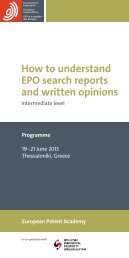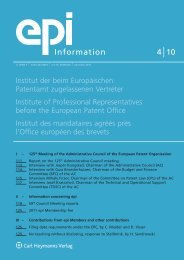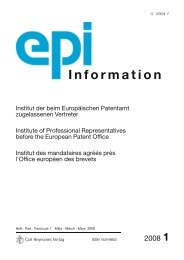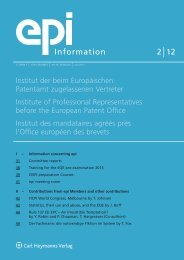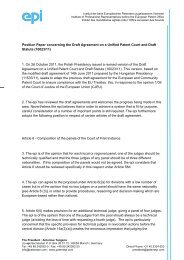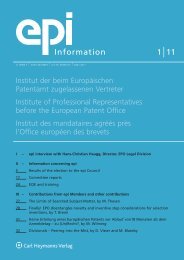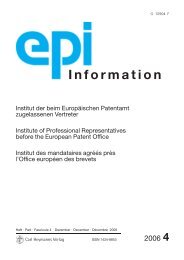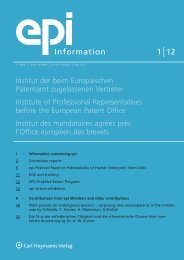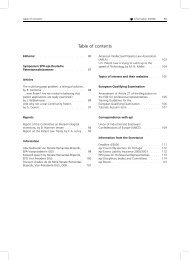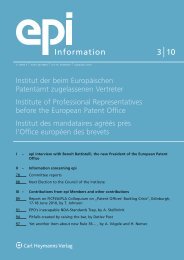epi Information 2/2009
epi Information 2/2009
epi Information 2/2009
Create successful ePaper yourself
Turn your PDF publications into a flip-book with our unique Google optimized e-Paper software.
60 Articles <strong>Information</strong> 2/<strong>2009</strong><br />
A ‚New Motivation’ –<br />
Quality, Backlogs and Fees at the EPO<br />
C. Treleven 1 (GB)<br />
1. Introduction<br />
The EPO’s 2007 Annual Report stated the following:<br />
’one of the most critical challenges of the moment is<br />
the accumulation of backlogs in the patent system. In<br />
addition, the Office is receiving fewer patent applications<br />
drafted in accordance with the EPC standard,<br />
which makes the applications substantially more difficult<br />
for examiners to process and quality patents more difficult<br />
to achieve.’<br />
This is a short, powerful summary of a situation that is<br />
very clearly in need of solution. The quotation focuses on<br />
the backlogs as being a challenge to the EPO. However,<br />
backlogs also have very significant negative effects on<br />
representatives, applicants and the general public.<br />
This article looks at the links between backlogs at the<br />
EPO, the quality of granted patents and the EPO’s fee<br />
structure. The EPC2000 revisions were intended to allow<br />
the EPO far greater freedom to change the way in which<br />
it operates. This article therefore also considers what the<br />
EPO could do with those powers, specifically at opportunities<br />
for building on the incentives introduced by the<br />
recent re-structuring of claims fees.<br />
The author of this article has worked as a European<br />
Patent Attorney both in private practice and in industry,<br />
and as an economics consultant.<br />
2. Background<br />
The EPO has operated with significant backlogs in<br />
search, examination, opposition and appeal for much<br />
of its 30 year history. The backlog in search dates back to<br />
the mid 1980s. Considering examination, the EPO’s<br />
2008 Annual Report states that, during 2007, ’the<br />
number of European Examination files awaiting a final<br />
outcome rose by 5.9% to 485700’.<br />
To their great credit, the staff at the EPO have faced<br />
this situation with resolve. For more than twenty years,<br />
including ten years in the 1980s and 1990s when the<br />
author of this article was an EPO examiner, the EPO has<br />
sought to raise its efficiency. Increases in efficiency have<br />
often involved a ’getting more from each examiner’<br />
approach.<br />
Recently, there has also been major progress on making<br />
the EPO more effective, effectiveness not being the<br />
same as efficiency.<br />
Since 1st April 2008, a fee of Euro200 per claim has<br />
been payable for the 16th and each subsequent claim.<br />
From 1st April <strong>2009</strong>, there has been a fee of Euro500for<br />
the 51st and each subsequent claim. These claims fees<br />
1 C. Treleven, European Patent Attorney, colin.treleven@optimus-patents.com<br />
now provide a strong incentive for applicants to review<br />
the number and structure of claims. This incentive is<br />
likely to bring significant changes to many European<br />
Patent Applications that are either based on an earlier<br />
national patent application, or which are based on an<br />
International Application filed through the PCT.<br />
A European Patent Attorney now has convincing<br />
arguments with which to persuade an applicant that it<br />
is worth investing time to amend claims, before an<br />
application reaches the EPO. This was not the case under<br />
the system of claims fees in force before April 2008.<br />
Under that system, any attempt by a European Patent<br />
Attorney to spend time amending claims before filing a<br />
European Patent Application would almost always cost<br />
more in ’chargeable time’ than it would have saved in<br />
EPO claims fees.<br />
The new claim fee structure demonstrates that applicants<br />
can be given strong incentives to be proactive, very<br />
early in the substantive examination process. However,<br />
the claim fee structure is simply one step towards<br />
improving the situation that ’the Office is receiving fewer<br />
patent applications drafted in accordance with the EPC<br />
standard’, see the quote in the introduction.<br />
Prior to filing, a European Patent Attorney in private<br />
practice still has few arguments available with which to<br />
persuade an applicant to do more than just react to the<br />
claims fees. Applicants know that many EPO examiners<br />
will produce a neat list of requirements, which the<br />
applicant can then address. The applicant needs only<br />
to expend time, and hence money, to make changes<br />
during substantive examination. A large majority of<br />
representatives are in private practice. So extensive work<br />
to bring a national or a PCT application into agreement<br />
with the EPC, prior to filing as a European Patent<br />
Application, is still unlikely to be the norm.<br />
The incentives introduced by the new claims fees show<br />
that further variations to the EPO’s fees would have<br />
strong effects on the condition of patent applications<br />
that are filed at the EPO. This would cut the workload for<br />
examiners, and also the time to reach grant. Here ’condition’<br />
means how close the patent application is to<br />
meeting the requirements of the EPC.<br />
3. What are the real effects of the backlogs?<br />
The effects of backlogs at the EPO are very great.<br />
However, because large backlogs have been part of<br />
the patent system for so long, it is hard for many people<br />
to see how they affect patent quality, and how much<br />
they cost.



